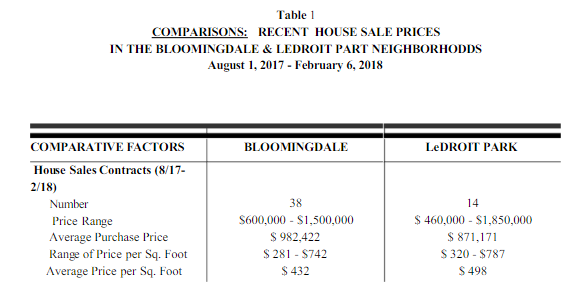This past week, Bloomingdale resident and real estate agent JC Blount and Bloomingdale Civic Association board member and ANC representative Dr. Bertha Holliday published an analysis purporting to show that designating Bloomingdale a historic district will not lead to a rise in housing prices in the neighborhood.
I’m very appreciative that Dr. Holliday and Ms. Blount are engaged in this analysis. I agree that trying to answer the question of how designation will impact our neighborhood’s already pressing affordability crisis is central to this debate. Unfortunately, I disagree that this particular analysis and data set are sufficient to answer this major question, or that it’s the right question to ask in the first place.

Chart from the Holliday-Blount analysis
The first issue is that the sample size considered here is exceedingly small. The LeDroit data set contains only 14 sales. At that small of a number, a couple of outliers one way or another can greatly impact the results.
Second, the analysis does not attempt to control for some of the obvious variables that could lead to said outliers – variables like condition of the property, amenities, lot size, relative location on the block (corner lot vs. mid-row), etc.
But most importantly, this analysis is looking at the wrong time period. If ultimately we’re trying to measure the impact of designation, we need to look at the changes that took place at the time of designation. In this case, LeDroit earned its designation in 1974, so I don’t think prices from the last six months are particularly applicable to answering that question.
More broadly though, I think it’s important to address the genesis of this analysis in the first place. The authors make clear that they feel like opponents of historic designation such as myself are misleading neighbors by claiming HD will “cause the cost of houses to soar.” (A similar concern was expressed last month by former BCA president Pat Mitchell when she described my initial post and our flyer as fearmongering akin to a zombie apocalypse.)
Both of these critiques seem overly concerned with an argument I’m not particularly making (property values) and somewhat silent on the one I’m highly focused on (repair and renovation costs).
The reality is that trying to find an academic consensus on the impact of historic designation on property values is notoriously difficult This search of scholarly literature, for example, brings up 3,500 results. A large number of those studies do find an upward pressure on prices, while others don’t. I think it’s safe to say that the housing market is a complicated dynamic and none of us know for certain what will happen if designation goes through. To that end, I’m also perfectly comfortable conceding that it is unlikely the impact of this singular change alone will lead to “soaring” prices or that “lots of people will lose their homes.” The reality is the answer to that argument is not central to the case against historic designation.
Because while we don’t know exactly what will happen with home prices, we do know with 100% certainty that more neighbors will face more costs (both monetary and in terms of time) when trying to repair or renovate their homes. Depending on the scope of work, that may be a few hundred dollars more or it may be tens of thousands of dollars more. As long as the rules limit options and require additional layers of approval, there will be some increased hardship on some people.
That’s obviously true of all regulations, though, and I’m not attempting to argue for laissez-faire homeowner rights. We don’t let homeowners use lead paint because we’ve collectively decided children’s health is more important. We require buildings conform to certain energy efficiency standards to limit our collective impact on our environment. And I’m sure builders could make houses cheaper if they didn’t have to follow proper fire code standards, but we rightly value the safety of the whole neighborhood more.
My point is that the question is not whether there will be a burden, but whether the benefit is worth that burden. To me, ensuring that the houses on my block look a certain way just doesn’t rise to the same level of something like the health and safety of our citizens and environment. In this case, I’d rather prioritize helping keep the costs of home-ownership as affordable as possible for everyone in Bloomingdale, particularly our low-income neighbors.
I think reasonable people can disagree on that, but I think we should be honest that’s the debate we’re having.
